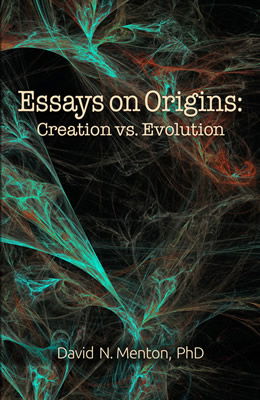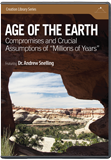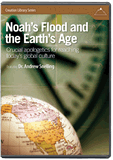
What a Difference a Day Makes!
Editor’s Note: First published in St. Louis MetroVoice 4, no. 12 (December 1994).
The lyrics of a popular song remind us, “What a difference a day makes—24 little hours.” Nowhere is this observation more profoundly true than in our proper understanding of the Hebrew word for day (yom) which occurs over 2,000 times in the Old Testament. Like our English word “day,” yom can be used to mean an ordinary 24-hour day or an indefinite period of time (such as “in the day of Abraham”). In both English and Hebrew, the intended meaning of “day” is generally obvious by the context in which it is used. For example, in over 100 instances where the phrase “evening and morning” accompany the word yom in the Old Testament (as it does in the days of Creation in Genesis), it always refers to an ordinary 24-hour day. Also, in all the places in Scripture where the word yom is preceded by a number (as it is in the days of Creation), it always means a 24-hour day. Despite these simple and quite obvious rules governing its use, interpretation of the Hebrew word yom in the Creation week of Genesis has become one of the most contested issues among professing Christians and Jews. How could this be, and is it really important?
Attempts have been made to interpret the days of Creation in a way consistent with the evolutionary time scale.
For centuries, the six days of Creation in Genesis were understood by nearly all Church Fathers and Biblical Hebrew scholars to be ordinary 24-hour days. However, due to the widespread acceptance of evolution over the last century and a half (even in the church), attempts have been made to interpret the days of Creation in a way consistent with the evolutionary time scale. Even many who accept fiat creation (Creation out of nothing through the power of God’s Word) feel compelled to somehow incorporate the evolutionary time scale, if not the evolutionary process itself, into the Genesis account of Creation. Thus, some creationists have attempted to stretch the seven “days” of the Creation week into several billion years.
The reason “old-earth creationists” have accepted the evolutionary time scale is they believe that current estimates of the ages of the earth and universe are absolute facts, with which it would be foolish to disagree. But estimations of both the age of the earth and the universe critically depend on unprovable assumptions regarding their origin. The prevailing evolutionary assumption regarding the origin of the universe is known as the “big-bang theory.” According to this view, the universe began with an outward expansion of a small and unimaginably dense ball of matter/energy known as the “singularity.” As the material (originally mere protons and hydrogen) expanded uniformly in all directions, it somehow condensed to form the various celestial objects such as the stars and planets, though this would not be expected. The essential evidence for this theory is that all stars seem to be continually moving away from one another (the so-called “red shift”). Thus the age of the universe is calculated, in part, by determining how long it would take for the universe to expand at its current rate to its current dimensions. Unfortunately, no one knows what the actual rate of expansion or dimensions of the universe are.
Estimates of the age of the universe based on “big-bang” assumptions have been in the range of 14–17 billion years. Recent evidence from the Hubble space telescope, however, has led astronomers to reduce their estimates of the age of the universe to 8–12 billion years.1 This has resulted in an embarrassing situation, where many of the stars in the universe are now thought to be older than the universe itself! For this and many other reasons, the “big-bang theory” has come under intense criticism in the scientific community. A growing number of cosmologists now favor the “plasma theory” for the origin of the universe. If the plasma theory prevails, we may expect to see the universe declared to be vastly older than any previous estimates.2
Perhaps the most popular evidence for an old universe is the apparent time required for light to reach the earth from our more distant stars. Some stars are estimated to be several billion light years away (a light year is the distance light travels in a year). Thus it is argued that since it would take billions of years for the light from such stars to reach the earth, these stars must have been in existence and emitting light for billions of years. Creationists who find this a compelling argument for an old universe apparently assume that even a God who can create stars by the power of His Word, must still wait patiently for their light to reach the earth. While young-earth creationists believe that God instantly created the stars and their long light beams (and thus only give the appearance of age),3 old-earth creationists counter that God would never instantly create anything with the appearance of age as this would be “deception.” The issue, however, is really one of God’s sovereignty, not deception.
The God who created light (to separate the day from the night on earth) three days before He created the sun would hardly have to wait for “poky” light beams! Not only starlight, but virtually everything God created would have the appearance of age at the very moment of its Creation. Consider something as simple as Eve’s hair for example. Eve is often pictured as a young woman (perhaps in her teens?), with scalp hair measuring about two feet in length. It would have required nearly 10 years for Eve’s hair to have grown to this length at current rates (.3 millimeters/day). Surely God was not obliged to create a bald Eve and then wait. Thus Eve’s hair, like every other part of her body, would give the appearance of age (actually the appearance of maturity) at the moment of her creation.
Old-earth creationists generally accept without question the ages given by evolutionary geologists for the various layers of the “geologic column.” The estimated ages of these sedimentary layers (which get increasingly older as you descend the column) are primarily based on the assumed evolutionary age of the fossilized organisms they contain. Thus, old-earth creationists are obliged to accept a progressive appearance of living organisms (whether by creation or evolution) spread out over hundreds of millions of years.
I will leave it to the reader to decide whether the worldwide death and destruction we see in the fossil record is more consistent with God’s work as a loving Creator or with His work as a wrathful destroyer.
Young-earth creationists, on the other hand, believe that the sedimentary layers of the geological column and its fossils were deposited in a short period of time by the Noachian Flood. Thus, while young-earthers see the geologic column and its fossils as evidence of God’s catastrophic punishment for sin, old-earthers interpret these same fossils as evidence of God’s good “creative” work! It is difficult to imagine more diametrically opposing views. I will leave it to the reader to decide whether the world-wide death and destruction we see in the fossil record is more consistent with God’s work as a loving Creator or with His work as a wrathful destroyer.
The major problem with accepting the geological column and its fossils as evidence of God’s “creative work” is that all fossils (including human fossils) are dead—stone-dead, in fact. This requires us to believe that suffering and death (for both man and animals) have been with us from the very beginning of Creation; indeed, that God intended for us to suffer and die. But the Bible teaches that God created everything perfectly and pronounced it “good.” Suffering and death are not natural, but rather came into the world through the sin of disobedience. This is the very essence and meaning of the Bible, and the purpose of Christ’s redemptive work.
Essays on Origins: Creation vs. Evolution
Footnotes
- October 2017 web version editor’s note: The current accepted age for the universe is 13.8 billion years.
- October 2017 web version editor’s note: Plasma theory has waned, but Multiverse theory is the newest popular theory.
- Print version editor’s note: God is sovereign and certainly could have created light in transit if desired. Since this article was written, a lot of study has been done in this area by astronomers, physicists, and cosmologists that accept a Biblical <10,000 year old universe; and they have offered several other models. One example is Gravitational Time Dilation. Readers interested in this topic may wish to investigate books and videos from Russell Humphreys, Jason Lisle, Danny Faulkner, and John Hartnett. Articles are also available at www.creation.com, www.answersingenesis.org and www.icr.org.
Recommended Resources

Answers in Genesis is an apologetics ministry, dedicated to helping Christians defend their faith and proclaim the good news of Jesus Christ.
- Customer Service 800.778.3390
- © 2024 Answers in Genesis




